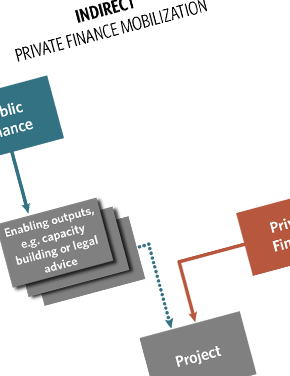Estimating Mobilized Private Finance for Adaptation: Exploring Data and Methods

Introduction
How to unlock finance in support of developing countries’ low-carbon and climate-resilient growth is a central issue of concern for policymakers around the globe. As evidence grows regarding the negative impacts of climate change on human health, economic activity, natural resources and physical infrastructure, finance in support of climate change adaptation has been attracting more attention, especially for countries that are the most immediately vulnerable to these adverse impacts.
In an effort to address this issue, during the 2009 United Nations Framework Convention on Climate Change (UNFCCC) negotiations in Copenhagen, developed countries committed to a goal of mobilizing jointly USD 100 billion a year by 2020 to address the climate mitigation and adaptation needs of developing countries. This funding is to come from a wide variety of sources, public and private, bilateral and multilateral, including alternative sources.
There are few known examples where public finance has mobilized private adaptation finance. This is to some extent due to the difficulties in tracking adaptation-related finance. More work is needed to better-understand how to identify, measure, and track public interventions that mobilize private finance for adaptation, and how similar interventions can be most effective in the future. Analysis has, however, so far primarily focused on mitigation, only partly dealing with adaptation due to significant data constraints and methodological challenges.
This study, undertaken as part of the OECD-hosted Research Collaborative on Tracking Private Climate Finance, aims to develop more comprehensive methodologies for estimating private finance flows mobilized by developed countries’ public interventions for climate action in developing countries.
The key findings of this study are provided below. The full study is available to download via a link provided under Further Resources.
Key Findings
- There is currently limited publicly-available data on private adaptation finance mobilized by public interventions in and to developing countries but promisingly, development finance institutions are developing methodologies to track private finance associated with their public climate finance interventions, covering both mitigation and adaptation finance.
- There is an inverse relationship between the accuracy of the approaches used to measure mobilized private finance and the incentives they provide on the one side, and their practicality and standardization potential on the other.
- Direct private finance mobilization is easier to identify and more practical to quantify than indirect mobilization. However, not considering the latter can lead to underestimations of total private finance mobilized, and to overestimating the direct mobilization impact of public financial support.
- Assuming that the provision of public support is in part motivated by the expected private finance mobilized, excluding indirect mobilization may disincentivize the provision of upstream project, technology, and market development support.
- A coherent use of approaches among public actors supporting an individual activity, project or program is needed to minimize risks of double counting. This is particularly the case where both upstream and downstream public finance interventions can claim to have participated in mobilizing the same private finance.
Methods
This study advances our understanding of private finance for climate change adaptation mobilized by public finance interventions by:
- Taking stock of data availability and on-going efforts to measure private finance mobilized for climate action in developing countries, including for adaptation activities
- Developing and evaluating a range of methodological options to estimate private finance mobilized by public adaptation finance
- Conducting case study-based pilot measurements of mobilized private adaptation finance by testing these methodological options on two bilateral public finance adaptation projects
This study develops four exploratory methodological approaches for measuring mobilized private adaptation finance. The approaches are based on the OECD Research Collaborative for Tracking Private Climate Finance’s framework of decision points, building on and expanding available methodological approaches for measuring mobilized private finance. They vary in how the following three key decision points are defined:
- Types of interventions considered, i.e., what types of public finance interventions we include as relevant in mobilizing private finance (e.g. co-finance, credit lines, public finance via technical assistance, support for capacity building activities, financial support for policy development, etc.).
- Accounting boundaries, i.e., the borders around which to include private finance associated with a given public intervention.
- Causality assessment, i.e., the process by which we determine whether and to what extent a public finance intervention caused private finance to be mobilized (meaning that private actors would not have become involved without the public intervention)
These approaches, which are described in full in the study, are tested on two case studies and evaluated against four assessment criteria defined and used by the Research Collaborative:
- Accuracy: reflects a realistic and complete depiction of which interventions enabled private finance to be mobilized;
- Incentives: encourages the use of public interventions to deliver climate benefits; promotes means to scale up finance for climate action;
- Potential for standardization: applicable to various types of reporting entities; allows for aggregation and comparison; avoids double counting across reporting entities; and
- Practicality: feasible with the data and expertise available; is time- and cost-efficient to report.
While they are tested in this report for adaptation finance, they are also directly relevant to assessing private finance mobilized for mitigation action. Even more broadly, these approaches could also potentially be used to evaluate the mobilization of private finance through public finance interventions for non-climate-specific
Authors
Jessica Brown (CPI), Martin Stadelmann (former CPI), and Raphaël Jachnik (OECD) were lead authors on the report. Takayoshi Kato (OECD) and Leonardo Boni (former CPI) were contributing authors.
(0) Comments
There is no content